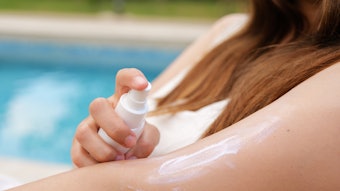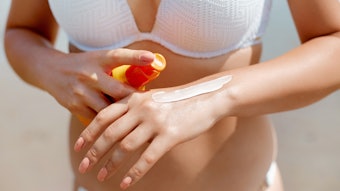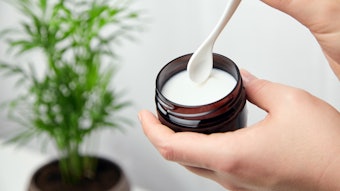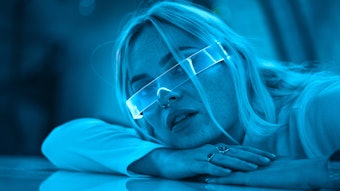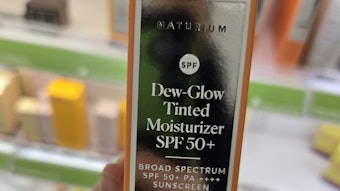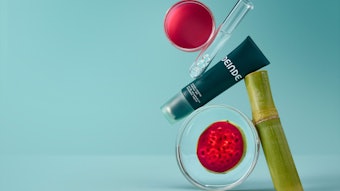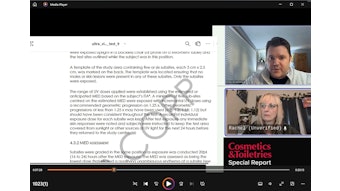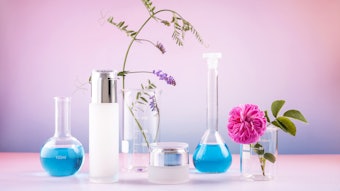
Editor’s note: This two-part article is controversial. In part I, it reviewed a number of concerns about the safety of traditional sunscreens. Here in part II, the authors propose new approaches to move past these issues. Whether or not you feel the expressed concerns are valid, this article is presented in the spirit of advancing cosmetic science to provoke thought, and in no way suggests consumers should stop using sun protection. We invite you to engage in this discussion by emailing [email protected] or commenting on our Cosmetics & Toiletries LinkedIn page.
Considering all the issues and concerns described in part I, it is worth exploring how to take sunscreens in a new direction. Recent research has focused on nature’s ways of protecting living organisms, from miniscule plankton and cyanobacteria to humans. And with the proper topical delivery systems, some of these biomechanisms may prove beneficial to human consumers and marketers. This section reviews several.
Sinapic acid: Plant-derived sinapic acid (see Figure 2) and its derivatives have been studied for photoprotective benefits. Sinapoyl malate and related molecules act through a multistep process involving internal conversion of the initially photoexcited 1(1)ππ* state along a trans-cis photoisomerization coordinate. This leads to the regeneration of the original trans ground-state isomer or the formation of a stable cis isomer. A cofactor agent that can convert cis-isomer in the presence of UV back to its trans-form could potentially provide an effective sunscreen agent based on sinapic acid.66
Mycosporines: Inspired by the strategies of fish, algae and microorganisms in confined ecosystems exposed to UV radiation, mycosporines, chitosan-bound mycosporines and mycosporine-like amino acids hold potential for new, safer and nature-inspired sunscreen compounds. Mycosporines and mycosporine-like amino acids are secondary metabolites of marine and terrestrial origin (see Figure 3). These water-soluble, UV-absorbing compounds are synthesized by a large variety of prokaryotic and eukaryotic organisms, including zooplankton and phytoplankton, in fresh-, salt-water and terrestrial environments.67
These materials are biocompatible, photo-resistant and thermo-resistant, and exhibit efficient absorption of both UVA and UVB radiations.68 Since they are of a natural and renewable origin, they may prove to be of interest for any future UV protective product development; of course, once they pass the usual safety and efficacy studies.
Another example is porphyra-334 from Porphyra yezoensis. This mycosporine-like amino acid has been studied for the prevention of photoaging. Porphyra-334 has been found to suppress reactive oxygen species production and the expression of matrix metalloproteinase following UVA irradiation. These results suggest porphyra-334 and the analogous palythine and asterina-330 may also serve as a novel anti-aging agents.69
Scytonemins: Scytonemins are biological pigments (see Figure 4) synthesized by various strains of cyanobacteria, including Calothrix and Lyngbya aestuarii. Scytonemins absorb strongly and broadly in the UVA and UVB regions. They recently have been shown to protect cyanobacteria against damage by UV radiation, although their exact mechanism is not yet known.70
Urocanates: Urocanates and their derivatives also are receiving attention as novel UV-protection agents; although they require further safety and efficacy evaluations in formulated products.71 The human body has its own defense mechanisms against excessive UV exposure. Besides melanins, urocanic acid (UCA), formed from the action of histidine ammonia lyase on L-histidine, acts as a natural sunscreen agent on skin.
The natural trans form of UCA is converted into its cis isomer upon exposure to UV, which can lead to the formation of various peroxide species via a cascade of biochemical steps (see Figure 5). It is therefore of paramount importance to convert the cis form back to its trans stereochemistry to reap UV protection benefits. This hurdle has turned interest away from photo-protective urocanates, although metal-doped urocanates have been proposed to solve this dilemma, based on a recently identified metal-binding prowess of UCA.72
It is also worthy to note cis-urocanic acid has shown anti-inflammatory and anticancer activity.73 This form can inhibit both local and systemic resistance to infectious agents.74 UVB impairs the induction of contact hypersensitivity by converting trans-UCA to cis-UCA within the epidermis. In turn, cis-UCA causes the local release of TNF alpha, which, by its ability to alter the functional program of epidermal Langerhans cells, prevents the induction of contact hypersensitivity.75
UV is known to induce skin cancer and suppress the immune response. To cause this immune suppression, the electromagnetic energy of UV must be absorbed by an epidermal photoreceptor and converted into a biological signal. Two photoreceptors have been recognized: DNA and trans-urocanic acid. Trans-UCA is normally found in the outermost layer of skin and isomerizes to the cis isomer upon exposure to UV. Immunosuppressive effects of cis-UCA and UV radiation are mediated by activation of the 5-HT2A receptor.76
Among topical applications, the immunosuppressive effect of cis-UCA has been translated into a practical cream formulation to treat eczema. In a clinical trial, cis-UCA cream reduced transepidermal water loss both in healthy subjects and patients. Eczema area severity index and physician’s global assessment also improved. Thus, cis-UCA cream both improved the skin barrier function and suppressed inflammation in the human skin.77
Furthermore, topical cis-UCA, unlike hydrocortisone and tacrolimus, has been reported an efficient treatment for acute and subacute skin inflammation, attenuating skin edema and erythema. The mechanism of this property has been linked to cis-UCA, which suppresses the Jun N-terminal kinase (JNK) signaling pathway and holds the potential to treat UV-B induced inflammatory defects. Topical drug therapy with cis-UCA may thus provide a safe treatment option in inflammatory skin disorders.78
Chitin: Chitin is a UV-protective crystalline structure found in crustacean shells. Alpha-chitin is composed of micro fibers, which are made up of nanofibrils 2-5 nm in diameter and 30 nm in length and embedded in a protein matrix. Crystalline nanofibrils can be prepared by acid treatment.
The effect of chitin nanofibrils (NF) and nanocrystals (NC) on skin using a three-dimensional skin culture model and Franz cells has been studied. The application of NF and NC to skin improved the epithelial granular layer and increased granular density. Furthermore, NF and NC application to the skin resulted in a lower production of TGF-β compared with a control group. NF and NC may also impart protective effects to skin; their potential in skin-protective formulations, especially sunscreens, merits consideration.79
The combination of nanofibers with other substances possessing UV-protective effects may provide enhanced protection against UVB radiation.
UCA plus chitin: Urocanic acid and chitin nanofibers (NFs) have been used to prepare urocanic acid chitin NFs (UNFs). Their protective effect against UVB radiation was studied in mice, which were coated with UNFs and irradiated with UVB. The treated mice showed markedly lower UVB radiation-induced cutaneous erythema than the control. Additionally, sunburn cells were rarely detected under the test conditions in the epidermis of UNFs-treated mice after UVB irradiation. This combination of NFs with other substances possessing UV-protective effects, such as UCA, may provide an enhanced protective effect against UVB radiation.80
Melanin: There is much to learn from human body’s own sun protection factors eumelanin and pheomelanin, especially the manner in which they provide UV protection without being decomposed, isomerized or fragmented into inactive components. This is due to their ultra-fast (nano-seconds) ability to process internal electronic conversions.
Ultra-fast internal conversions (IC) in photoexcited molecules are spin-allowed processes and constitute efficient radiationless decay pathways in photoactive biological molecules such as melanins. Melanins, due to their long chain helices of coiled conjugated organic molecules, offer photoprotection via their high absorption cross-sections and high IC efficiencies.
Upon near-UV, visible or near-IR absorption by a sunscreen, rapid dissipation of the excess excited state energy is required in order to ensure photostability (see Figure 6). This energy dissipation is usually in the form of IC to the ground electronic state, followed by cooling of vibrational energy, which dissipates as heat.81, 82
However, as the epidermal layers of skin continue to shed, melanin is lost. Therefore, skin melanocytes are activated by exposure to UV to secrete melanin-containing melanosomes to protect the skin from UV-induced damage. Despite the replacement rate of the epidermis, the turnover rate of melanocytes is slow, as they survive for long periods. Relative to this mechanism, it has been suggested that extracellular vesicles enriched in fibronectin are involved in melanocyte survival; melanocytes secrete these vesicles to increase their survival following UVB radiation.83
The use of melanins in sunscreen products for topical application would be a natural extrapolation of mechanistic benefits noted above. However, pheomelanin has been implicated in the susceptibility to UV-induced melanoma for individuals with light skin and red hair. Pheomelanin’s pro-oxidant properties, which cause the generation of reactive oxygen species and/or deplete cellular antioxidants, are the suspects.
While both eumelanin and pheomelanin are redox-active, they can efficiently cycle between oxidized and reduced states. However, pheomelanin possesses a stronger oxidative redox potential, which suggests pheomelanin’s redox-based pro-oxidant activity may be the causative factor for oxygen-dependent depletion of glutathione and other cellular antioxidants.84
Not surprisingly, the same biochemical mechanisms that can treat an affliction or symptom through up- and down-regulation of gene-controlled enzymes can also reverse their course. As such, an active may provide efficacy in one area of application, and be not so friendly in another. For example, melanin may be carcinogenic as well as protect against cancer. This paradox exists since exposure to UVA produces DNA photoproducts, cyclobutane pyrimidine dimers (CPDs), which are created picoseconds after a UV photon is absorbed by thymine or cytosine. CPDs are the major causes of apoptosis and photocarcinogenesis; they induce mutagenicity and immunosuppressive effects.85
Melanin-based approaches to UV protection have been reported. For example, one UV-resistant melanin was produced by Bacillus thuringiensis.86 Another melanin was derived from Auricularia auricula for commercial application in food and cosmetics.87 Yet another extracellular melanin was developed from the mushroom Schizophyllum commune, which showed high free radical-scavenging activity.88
Yet another, from the marine actinobacteria Actinoalloteichus sp., showed strong superoxide radical-scavenging activity, nitric oxide-scavenging activity, reducing power and metal chelating activity. Thus, melanin could potentially be used as a natural antioxidant in the food, cosmetic and pharmaceutical industries.89
Photosomes: The organelles of polynoïd annelids contain photosomes, which are pseudocrystals of endoplasmic reticulum and emit bioluminescence in response to stimulation. Polynoidin, the membrane photoprotein, is triggered by superoxide radicals to emit this bioluminescence.90 This photoreaction has been proposed to repair DNA damage caused by UV resulting in the formation of cyclobutane pyrimidine dimers.
In one study, photolyase enzyme in Anacystis nidulans was activated to affect electron transfer between the flavin adenine dinucleotide (FAD or flavin) and cyclobutane pyrimidine dimer. This resulted in DNA repair by excision repair of the UV photoproducts.91 Plankton extract from Anacystis nidulans, which may contain deoxyribodipyrimidine photo-lyase, have been formulated in DNA-damage preventive sunscreen formulations.92
Among other microbe-based DNA repair agents, 8-oxoguanine DNA glycosylase has received attention.93 An extract from brown alga, Laminaria ochroleuca, has been found to reduce skin inflammation.94 The use of this extract in sunscreens to reduce UV-caused inflammation has been suggested.95 Also, the extract from thermal bacteria, Thermus thermophilus, has been reported to repair damage caused by UVA and to protect against oxygenated free radicals.96 Most of these materials are also antioxidants.
Antioxidants in Sunscreen: Yea or Nay?
Considering the damaging effects of solar radiation, it would seem logical to formulate an antioxidant and/or an anti-inflammatory agent, or even an analgesic, into an after-sun skin care product. However, the reduction of inflammation, pain and/or redness, which are signals from the body, could cause excessive damage due to inadvertent over-exposure to sun. And most organic sunscreens possess antioxidant—and therefore anti-inflammatory—properties.
Is it a good practice to use additional antioxidants and anti-inflammatory agents in an SPF formula? In agreement with U.S. Food and Drug Administration (FDA) concerns, this topic has ignited opposing opinions,97 especially in light that antioxidants and antioxidant-sunscreen hybrids are reported to stabilize the photodegradation of organic sunscreens.98
Natural Oils and Extracts
The potential for natural oils and fruit and vegetable juices as topical UV-absorbing agents has also been explored. In particular, UV absorption was measured in vitro for: canola, citronella, coconut, olive and soybean oils; vitamin E; aloe vera; and fruit and vegetable juices and powders such as acerola, beet, grape, orange carrot, purple carrot
and raspberry.
Their mean absorptivity was compared with FDA-approved UV absorbers. Oils were at least two orders of magnitude lower compared with organic sunscreens. The fruit juice powders showed one order of magnitude lower absorptivity, although formulations containing purple carrot juice showed good UV-screening capabilities.99 The fruit juice powders were more effective at UV flitering; however, they still exhibited UV absorption one magnitude lower than commercial UV filters.100
This low UV absorption of natural oils suggests with the proper safety and efficacy testing, they could be used in combination with organic sunscreens. As an example, the incorporation of oxybenzone into nano-structured lipid carriers using oleic acid greatly increased the in vitro sun protection factor and erythemal protection factor more than six- and eight-fold, respectively, while also providing a very low irritation potential profile.101
In addition to oils and juices, a number of natural products derived from propolis, plants, algae and lichens have shown potential photoprotection properties against UV exposure-induced skin damage.102
Inspired by strategies of fish, algae and microorganisms in confined ecosystems that are exposed to UV, mycosporins hold potential for new, safer and nature-inspired sunscreen compounds.
Diamonds in the Rough
Nano-sized TiO2 and ZnO are well-known to provide photo-protection; although as stated, concerns have been raised regarding their photocatalytic activity. In some world markets, coated versions of these pigments are used to help prevent such activities, but this is not always the case. As an alternative, nano-diamonds (NDs) do not present such concerns.
In a mouse model, the application of 2 mg/cm2 of NDs was found to efficiently reduce more than 95% of UVB radiation, whereas in untreated mice, UVB exposure caused the death of cultured keratinocytes and damage to fibroblasts and the skin. NDs have thus been proposed as safe materials for preventing UVB-induced skin damage.103 Could diamond-bound sunscreens be too far-fetched? They may be a future possibility via Bingel-Hirsh-type reactions (see Figure 7), utilizing diamond-like adamantanes and fullerenes.104 Note, certain fullerene derivatives may be especially attractive for skin protection, albeit not in their nano-sized forms.105
Chemical Bonding: A Glimmer of Hope
There is hope for organic sunscreens: through encapsulation in hollow particles or incorporation into covalently bonded solid particles. This approach shows promise to overcome their phototoxicity and degradation concerns. As an example, when particles were prepared with 2-ethylhexyl salicylate attached to a silica matrix through single silsesquioxane groups, this covalent attachment reduced leaching and photodegradation over physical encapsulation methods.106
Conclusion
In view of the scientific information presented, a consumer-preferred, ideal sunscreen would, among other factors, be expected to:
- Provide maximum protection against all skin-damaging wavelengths of light
- Require a minimal application rate
- Cause no physical (skin irritation, inflammation), chemical (formula decomposition or harmful degradation by-product formation), or biological (DNA damage, gene-alteration) side effects
- Not absorb into the skin and be transported into the bloodstream
- Be renewably sourced and cost effective
- Have no adverse impact on the environment or ecosystems
We are a long way from developing this ideal sunscreen.107 It will require an orchestrated, multidisciplinary and internationally financed effort by all: the private and public sectors, regulatory agencies and academia, to provide the best possible UV protection for consumers. Among the key roadblocks to such an achievement has been a lack of recognition of the above consumer needs by both researchers and marketers.
Furthermore, marketers need new and innovative ways to promote nature-inspired sun protection in a manner out-skirting any international regulatory agency-related issues. As most will agree, it’s all in the verbiage of a claim; and as we all can agree, UV protection by sunscreens alone is not enough and complementary alternate strategies may also be required.108
References
- Baker et al, Ultrafast photoprotecting sunscreens in natural plants, J Phys Chem Lett 7 7(1) 56-61(Jan 2016) doi: 10.1021/acs.jpclett.5b02474
- Volkmann et al, FEMS Microbiol Lett 255 286–295 (2006)
- Fernandes et al, Exploiting mycosporines as natural molecular sunscreens for the fabrication of UV-absorbing green materials, ACS Appl Mater Interfaces 5 7(30) 16558-64 (Aug 2015) doi: 10.1021/acsami.5b04064; Colabella et al, UV sunscreens of microbial origin: Mycosporines and mycosporine-like aminoacids, Recent Pat Biotechnol (Jan 1, 2015); ncbi.nlm.nih.gov/pubmed/25619303; Rastogi et al, Photoprotective compounds from marine organisms, J Ind Microbiol Biotechnol 37(6) 537-58 (Jun 2010) doi: 10.1007/s10295-010-0718-5
- Ryu et al, Protective effect of porphyra-334 on UVA-induced photoaging in human skin fibroblasts, Int J Mol Med 34(3) 796-803 (Sep 2014) doi: 10.3892/ijmm.2014.1815; ncbi.nlm.nih.gov/pubmed/24946848
- Proteau et al, The structure of scytonemin, an ultraviolet sunscreen pigment from the sheaths of cyanobacteria, Experientia 49(9) 825-9 (Sep 15, 1993); Rastogi et al, Ultraviolet radiation and cyanobacteria, J Photochem Photobiol B 141 154-69 (Dec 2014) doi: 10.1016/j.jphotobiol.2014.09.020
- Ito et al, Protective effect of chitin urocanate nanofibers against ultraviolet radiation, Mar Drugs 13(12) 7463-75 (Dec 19, 2015) doi: 10.3390/md13127076; ncbi.nlm.nih.gov/pubmed/26703629
- Wezynfeld et al, is-Urocanic acid as a potential nickel(II) binding molecule in the human skin, Dalton Trans 43(8) 3196-201 (Feb 28, 2014) doi: 10.1039/c3dt53194e; Gupta, Protection of skin from UV and peroxide, US Pat 7,993,630 (Aug 9, 2011)
- Konkol et al, Intravesical treatment with cis-urocanic acid improves bladder function in rat model of acute bladder inflammation, Neurourol Urodyn (Jul 14, 2015) doi: 10.1002/nau.22818; ncbi.nlm.nih.gov/pubmed/26175302; Arentsen et al, Antitumor effects of cis-urocanic acid on experimental urothelial cell carcinoma of the bladder, J Urol 187(4) 1445-9 (Apr 2012) doi: 10.1016/j.juro.2011.11.080
- Malina, Urocanic acid and its role in the photoimmunomodulation process, Cas Lek Cesk 142(8) 470-3 (Aug 2003); ncbi.nlm.nih.gov/pubmed/14626561
- Kurimoto et al, Deleterious effects of cis-urocanic acid and UVB radiation on Langerhans cells and on induction of contact hypersensitivity are mediated by tumor necrosis factor-alpha, J Invest Dermatol 99(5) 69S-70S (Nov 1992)
- Walterscheid et al, cis-Urocanic acid, a sunlight-induced immunosuppressive factor, activates immune suppression via the 5-HT2A receptor, Proc Natl Acad Sci US 103(46) 17420-5 (Nov 14, 2006); Kaneko et al, cis-Urocanic acid stimulates primary human keratinocytes independently of serotonin or platelet-activating factor receptors, J Invest Dermatol 129(11) 2567-73 (Nov 2009) doi: 10.1038/jid.2009.129
- Peltonen et al, Three randomized phase I/IIa trials of 5% cis-urocanic acid emulsion cream in healthy adult subjects and in patients with atopic dermatitis, Acta Derm Venereol 94(4) 415-20 (Jul 2014) doi: 10.2340/00015555-1735
- Laihia et al, Topical cis-urocanic acid attenuates oedema and erythema in acute and subacute skin inflammation in the mouse, Br J Dermatol 167(3) 506-13 (Sep 2012 doi: 10.1111/j.1365-2133.2012.11026.x; Jauhonen et al, cis-Urocanic acid inhibits SAPK/JNK signaling pathway in UV-B exposed human corneal epithelial cells in vitro, Mol Vis 17 2311-7 (2011)
- Ito et al, Evaluation of the effects of chitin nanofibrils on skin function using skin models, Carbohydr Polym 101 464-70 (Jan 30, 2014) doi: 10.1016/j.carbpol.2013.09.074
- Ito et al, Protective effect of chitin urocanate nanofibers against ultraviolet radiation, Mar Drugs 13(12) 7463-75 (Dec 19, 2015) doi: 10.3390/md13127076
- Cole et al, Metal oxide sunscreens protect skin by absorption, not by reflection or scattering, Photodermatol Photoimmunol Photomed 32(1) 5-10 (Jan 2016) doi: 10.1111/phpp.12214
- Karsili et al, J Phys Chem A 118, 11999–12010 (2014); Tarras-Wahlberg et al, J Invest Dermatol 113 547–553 (1999); Bennet et al, Evaluation of UV radiation-induced toxicity and biophysical changes in various skin cells with photo-shielding molecules, Analyst 140(18) 6343-53 (Sep 21, 2015) doi: 10.1039/c5an00979k
- Bin et al, Fibronectin-Containing extracellular vesicles protect melanocytes against ultraviolet radiation-induced cytotoxicity, J Invest Dermatol (FEb 5, 2016) pii: S0022-202X(16)00461-9, doi: 10.1016/j.jid.2015.08.001; Yamamoto et al, Melanin production through novel processing of proopiomelanocortin in the extracellular compartment of the auricular skin of C57BL/6 mice after UV-irradiation, Sci Rep 5 14579 (Sep 29, 2015) doi: 10.1038/srep14579
- Kim et al, Reverse engineering applied to red human hair pheomelanin reveals redox-buffering as a pro-oxidant mechanism, Sci Rep 5 18447 (Dec 16, 2015) doi: 10.1038/srep18447; Napolitano et al, Pheomelanin-induced oxidative stress: Bright and dark chemistry bridging red hair phenotype and melanoma, Pigment Cell Melanoma Res 27(5):721-33 doi: 10.1111/pcmr.12262 (Sep 2014)
- Premi et al, Photochemistry. Chemiexcitation of melanin derivatives induces DNA photoproducts long after UV exposure, Science 347(6224) 842-7 (Feb 20, 2015) doi: 10.1126/science.1256022; Abdel-Malek et al, Dark CPDs and photocarcinogenesis: The party continues after the lights go out, Pigment Cell Melanoma Res 28(4) 373-4 (Jul 2015) doi: 10.1111/pcmr.12381; Mandal et al, Feasibility of ionization-mediated pathway for ultraviolet-induced melanin damage, J Phys Chem B 119(42) 13288-93 (Oct 22, 2015) doi: 10.1021/acs.jpcb.5b08750; Goto et al, Detection of UV-induced cyclobutane pyrimidine dimers by near-infrared spectroscopy and aquaphotomics, Scientific Reports 5 article # 11808 (2015); doi:10.1038/srep11808
- Sansinenea et al, An ultra-violet tolerant wild-type strain of melanin-producing Bacillus thuringiensis, Jundishapur J Microbiol 8(7) e20910 (Jul 27, 2015) doi: 10.5812/jjm.20910v2. eCollection 2015; ncbi.nlm.nih.gov/pubmed/26421136
- Sun et al, Production of natural melanin by Auricularia auricula and study on its molecular structure, Food Chem 190 801-7 (Jan 1, 2016) doi: 10.1016/j.foodchem.2015.06.042
- Arun et al, Extracellular melanin produced by mushroom Schizophyllum commune at a concentration of 50 μg/mL, melanin showed high free radical scavenging activity, Indian J Exp Biol 53(6) 380-7 (Jun 2015)
- Manivasagan et al, Isolation and characterization of biologically active melanin from Actinoalloteichus sp. MA-32, Int J Biol Macromol 58 263-74 (Jul 2013) doi: 10.1016/j.ijbiomac.2013.04.041
- Bassot et al, Bioluminescence in scale-worm photosomes: The photoprotein polynoidin is specific for the detection of superoxide radicals, Histochem Cell Biol 104(3) 199-210 (Sep 1995)
- Dushanov et al, A novel approach to simulate a charge transfer in DNA repair by an Anacystis nidulans photolyase, Open Biochem J 8 35-43 (Mar 7, 2014) doi: 10.2174/1874091X01408010035, eCollection 2014; Wijaya et al, Flavin adenine dinucleotide chromophore charge controls the conformation of cyclobutane pyrimidine dimer photolyase a-helices, Biochemistry 53(37) 5864-75 (Sep 23, 2014) doi: 10.1021/bi500638b
- https://cdn.shopify.com/s/files/1/0150/6346/files/AspireLIFE_Efficacy_Report_aug_2012_red_size.pdf (Accessed Feb 21, 2016)
- Kershaw et al, Repair of oxidative DNA damage is delayed in the Ser326Cys polymorphic variant of the base excision repair protein OGG1, Mutagenesis 27(4) 501-10 (Jul 2012) doi: 10.1093/mutage/ges012; Janssen et al, DNA repair activity of 8-oxoguanine DNA glycosylase 1 (OGG1) in human lymphocytes is not dependent on genetic polymorphism Ser326/Cys326, Mutat Res 486(3) 207-16 (Aug 9, 2001)
- Bonneville et al, Laminaria ochroleuca extract reduces skin inflammation, J Eur Acad Dermatol Venereol 21(8) 1124-5 (Sep 2007)
- tradeindia.com/fp1848904/Antileukine-6.html (Accessed Feb 21, 2016)
- ulprospector.com/en/na/PersonalCare/Detail/1240/44349/Venuceane (Accessed Feb 21, 2016)
- Hayder et al, Sunscreen regulations and use of anti-inflammatory agents in sunscreens, Dermatol Online J 19(7) 18969 Jul 14, 2013; ncbi.nlm.nih.gov/pubmed/24010515; Lim et al, What is the significance of anti-inflammatory activity of UV filters in sunscreens? JAAD 69 3,483 (2013); Sayre et al, Sun-protection factor confounded by antiinflammatory activity of sunscreen agents? J Am Acad Dermatol 69 481 (2013)
- Afonso et al, Photodegradation of avobenzone: Stabilization effect of antioxidants, J Photochem Photobiol B 140 36-40 (Nov 2014) doi: 10.1016/j.jphotobiol.2014.07.004; Reis et al, Synthesis, antioxidant and photoprotection activities of hybrid derivatives useful to prevent skin cancer, Bioorg Med Chem 22(9) 2733-8 (May 1, 2014) doi: 10.1016/j.bmc.2014.03.017
- Gause et al, UV blocking potential of oils and juices, Int J Cosmet Sci (Nov 27, 2015) doi: 10.1111/ics.12296; ncbi.nlm.nih.gov/pubmed/26610885
- Gause et al, UV-blocking potential of oils and juices, Int J Cosmet Sci 38(4) 354-63 (Aug 2016) doi: 10.1111/ics.12296; ncbi.nlm.nih.gov/pubmed/26610885
- Sanad et al, Formulation of a novel oxybenzone-loaded nanostructured lipid carriers (NLCs), AAPS PharmSciTech 11(4) 1684-94 (Dec 2010) doi: 10.1208/s12249-010-9553-2; Fang et al, Nanostructured lipid carriers (NLCs) for drug delivery and targeting, Recent Pat Nanotechnol 7(1) 41-55 (Jan 2013)
- Saewan et al, Natural products as photoprotection, J Cosmet Dermatol 14(1) 47-63 (Mar 2015) doi: 10.1111/jocd.12123
- Wu et al, Nanodiamonds protect skin from ultraviolet B-induced damage in mice, J Nanobiotechnology 13 35 (May 7, 2015) doi: 10.1186/s12951-015-0094-4
- Functionalization of Carbon Nanomaterials, Thakur and Thakur, eds, CRC Press (2016); Li et al, Bingel–Hirsch reaction on Sc2@C66: A highly regioselective bond neighboring to unsaturated linear triquinanes, J Phys Chem C 119 (46) 26196–26201 (2015) doi: 10.1021/acs.jpcc.5b08698
- Silpa et al, Nanotechnology in cosmetics: Opportunities and challenges, J Pharm Bioallied Sci 4(3) 186–193 (Jul-Sep 2012); ncbi.nlm.nih.gov/pmc/articles/PMC3425166; Hsu et al, Molecular dynamics simulations predict the pathways via which pristine fullerenes penetrate bacterial membranes, J Phys Chem B 120(43) 11170-11179 (Nov 3, 2016); ncbi.nlm.nih.gov/pubmed/27712070; Lens, Recent progresses in application of fullerenes in cosmetics, Recent Pat Biotechnol 5(2) 67-73 (Aug 2011); ncbi.nlm.nih.gov/pubmed/21619548
- Tolbert et al, New hybrid organic/inorganic polysilsesquioxane-silica particles as sunscreens, ACS Appl Mater Interfaces 8(5) 3160-74 (FEb 10, 2016) doi: 10.1021/acsami.5b10472
- Osterwalder et al, The long way toward the ideal sunscreen—Where we stand and what still needs to be done, Photochem Photobiol Sci 9(4) 470-81 (Apr 2010) doi: 10.1039/b9pp00178f; personal-care.basf.com/docs/press_center-pressemeldungen-2012/cossma_sonnenschutzmittel_excl_062012_en?sfvrsn=0
- http://gcimagazine.texterity.com/gcimagazine/january_february_2016?pg=40#pg40; Rogers et al, A new day for sun care, Global Cosm Indust 32-35 (Jan/Feb 2016); http://gcimagazine.texterity.com/gcimagazine/january_february_2016?pg=36#pg36 (Accessed Feb 24, 2016)

